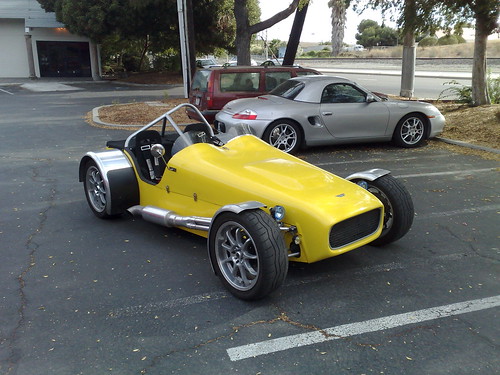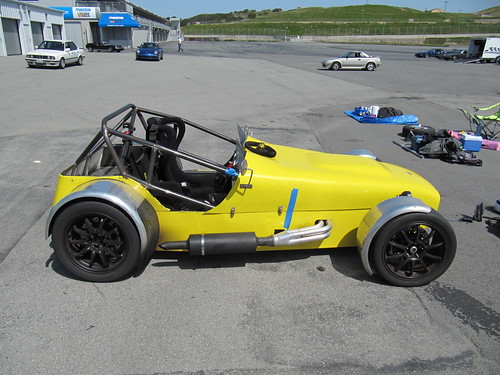When I initially purchased the Ultralite it was running on a set of generic 7.5″ wide alloys with 235-width Falken Azeni RT-615 tires all around(above). While the Azenis are decent tires (we use them on the Lemons car), they are still street tires and just cannot cope with the absurd power of the seven. After having a few moments of wheelspin in 3rd gear, I decided that while long slides are fun, I did want to go to more grippy setup as well as increase the rear grip level to give the car some better balance.
I quickly learned that one of the more annoying things about having a kit car is the extreme amount of pain you have to go through to get a set of wheels. While most kit cars use off the shelf components from production cars for their hubs, they generally also use parts off different cars front to rear and have very different offsets anyway. In the case of the Ultralite it uses 5×100 bolt pattern with with the most common wheel sizes being a 17×8 fronts (offset 35-38) and 17×9/10 rear (45×48 offset). Now the unfortunate part is that while the specifications themselves are fairly common (Subaru WRX), I could not find a single large scale wheel maker that makes both sizes (8″ and 10 “) in the same wheel design. I should also add that 99% of the online sites out there only allow you to sear for wheels by car model and not by wheel specs which made the tire search extremely frustrating.
The only viable option that I found were the Team Dynamics Pro Race 1.2 wheels that are used by a few other Ultralite owners out there. They are an afforable option and by all accounts stand up well to regular track use. Unfortunately because they are a fairly small operation out of England, the US importers have quite a limited stock of wheels which meant that I would have to special order the wheels and that could take anywhere from 2-6 months to get here.
At this point I happened to take my wheels off only to find that one of the wheel studs on the left front wheel was loose. I gently unscrewed the stud by hand only to find a large amount of aluminium shavings in the stud threads. It appeared that at some point in the past, a previous owner waaaay overtightened the lug nuts on the wheel and literally stripped the stud out of the hub. Additionally a couple of the studs were at a slight angle from horizontal which along with the stripping meant that the hub damage was too extensive to repair.
I contacted Brian Andersen at World Class Motorsports to get a part number for the hub only to find that the hub was actually a custom part that WCM modified before they put it on the car. They took a stock Wilwood Pinto hub with an existing 5×114 and 5×120 bolt pattern and machined a set of 5×100 pattern holes to which they added the wheel studs. This was probably done such that the bolt pattern on the front wheels would match the stock Subaru 5×100 pattern on the rear hubs. Unfortunately this also meant that if I bought a new hub I would would have to find someone to custom drill the new pattern into place for me. At this point I had the sudden brainwave that since the existing hub was mechanically sound (only the 5×100 stud openings were damaged) and still had other bolt patterns, I could just switch to a different bolt pattern and keep using the same hub. Luckily I had delayed placing an order for the Team Dynamics wheels which meant that I could just buy the front wheels with new bolt pattern without any wheel fitment issues. I went ahead and got a couple of multi-drilled rotor hats (existing ones were 5×100 only) with some ARP studs and quickly changed the front wheels to a 5×114 bolt pattern which allowed me to reuse the existing hubs and gave me access to a wider selection of front wheel options.
At this point I decided that I could not wait the 2-6 months for the Team Dynamics wheels and instead began investigating other wheel options. I came across the Wheeldude.com folks who had a good selection of Rota wheels and had the added benefit of being local (Fremont). While looking through their website I found that while they did not have any one line of wheels that would fit both my front and rear wheel requirements, they did have a number of different wheel lines that looked similar enough that you wouldn’t really notice the difference. After going through several different options, I decided that setup of G-force fronts and DPT rears would likely be my best bet. I then went over to their warehouse and got to see a couple of the actual wheels and compare them side-by-side before picking a set of 5×114 17×8 G-forces for the front and dual drilled 5×100/114 17×9 DPTs for the rear ($750 for the full set). An additional benefit of getting the DPTs for the rear is that I can in future move to the upgraded WRX STI rear end (5×114 hubs) and continue using the same wheel set.
The next step was to figure out the tires to use and it was a pretty easy decision to go for an R-compound tire. Sure I would have no grip in the rain or in sub-zero conditions but the chances of encountering either condition in a roofless, door-less, windshield-less car in California are pretty low :). Additionally I had been using Toyo RA-1 tires on my Elise for the last year and was very impressed with not only their grip but also how they do not have any heat-cycling issues (important on a lightweight car like the Seven). Unfortunately Toyo has discontinued making the RA-1 and though they are planning to restart production for 2010 there were no estimate for when the tires would actually reach dealers.
Since my preferred option was not available I had to decide between the Yoko AO48, Nitto NT01 and the Toyo R888s. Both the AO48 and the R888 tires are pretty common in the Elise community and from all the feedback I was hearing they appear to be good tires with a high peak grip but are prone to getting greasy after several laps and also heat cycle before they run out of tread depth. The RA-1s in comparison have a slightly lower peak grip but instead will maintain the same level of grip after several laps and can be used all the way to the cords without any heat cycling out. Since I will only be using the Seven for recreational driving and non-competition events, peak grip isn’t an issue and with the light weight (1300 lbs), heat cycling resistance is much more important than tire wear. Looking further into the Nitto NT01 option, I was surprised to find that Nitto was actually a subsidiary of Toyo and the NT01 apparently uses the same rubber compound as the discontinued RA1. A little more investigation showed that Discount Tire Direct would sell me a a set of 4 tires for ~$725 shipped which also made them the cheapest option by far 😀
So in the end after about 2 months of searching and modifying the bolt pattern I ended up with 235/40ZR-17 Nitto NT01s on 17×8 Rota G-Forces up front with 275/40ZR-17 Nitto NT01s on 17×9 Rota DPTs on the back. As you can see from the pictures below, the wheels actually match quite well and people don’t realize that they are different front to rear until I explicitly point it out.
So far I have only used the car for street events and one truncated track day at Laguna Seca but even in this short span I have to say that the wheel combo is very well balanced and it now takes some intentional provacation before the rear wheels start spinning. In terms of absolute grip I was able to easily pull 1.2 G at Laguna despite having a lot suspension issues and not pushing very hard. Once I get the setup sorted out and start really pushing the car I expect that the G meter will be reading quite a bit higher. I should also add that I have been running the tires at about 15 psi hot all around which seems to work pretty well. Tire pressure only goes up by about 2-3 psi during a track session which may not sound like much on a regular car but its a 20% increase when you start at such low pressures.



One reply on “Setting up a Seven – Wheels and Tires”
[…] Rota Wheels with Nitto NT01 R-compound tires […]